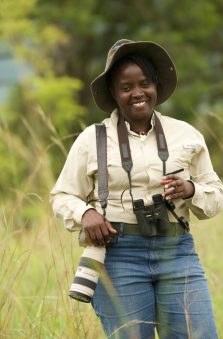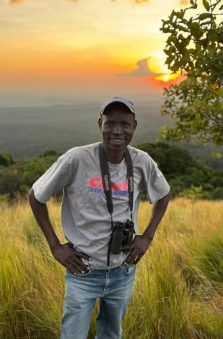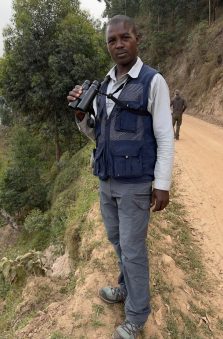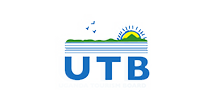Uganda Important bird areas
Important Birding Areas in Uganda
Uganda is a paradise for birdwatchers, with over 1,000 bird species found in various habitats across the country. From wetlands and forests to savannahs and mountains, Uganda offers some of the best birding experiences in Africa. Below are some of the most important birding areas in Uganda.
Bwindi Impenetrable National Park
Bwindi is home to approximately 350 species of birds, including 23 Albertine Rift endemics. And at least 14 species were recorded nowhere else in Uganda! It ranks as one of the best forest birding destinations in Africa, with local bird guides who are capable of identifying most species by call and even calling up the more responsive species by their lip and whistle sounds. The likes in this forest include; (Albertine rift endemics) Red-throated Alethe, Archer’s Robin-chat, Yellow-eyed Flycatcher, Chapin’s Flycatcher, Blue-headed Sunbird, Regal Sunbird, Rockeffeller’sSunbird, Purple-breasted Sunbird, Strange Weaver, Dusky Crimson-wing, Red-collard Mountain Babbler, Chapin’s Mountain Babbler, Grauer’s Warbler, Neumann’s’ Warbler, Prigogine’s Greenbul, Black-faced Apalis, Collard Apalis, Stripe-breasted Tit, Grauer’sCukooshrike, Red-Billed Helmet shrike, Ruwenzori Batis, African Green Broadbill, Dwarf Honeyguide, Prigogin’s Nght-jar, Albertine Owlet, Congo Bay-owl, Ruwenzori Turaco, Handsome Francolin and other birds.
Mabamba Bay Wetland
Home to the Shoebill Stork
It is one of the few remaining productive wetlands in Uganda, protected by local communities. Extensive papyrus swamps with labyrinthine channels and lagoons, classified as an Important Bird Area (IBA), are home to multiple Shoebills — Uganda's most famous avian resident and the only representative in its family, which is among the most sought-after birds on the entire African continent. It's only traced by canoeing through the channels with a wooden boat. Other likes of Mabambainclude; Papyrus Gonolek, Blue-breasted Bee-eater, Lesser Jacana, African Jacana, White-winged Black Tern, Grey-headed Gull, African skimmers, Little Egret, Long-toed Lapwing, Spur-winged Lapwing, African Fish-eagle, Goliath Heron, Purple Heron, Common Squacco Heron, Striated Heron, Blue-headed Coucal, Malachite Kingfisher, Black Crake, Hamerkop, African Marsh-harrier, Yellow-billed Duck, Hadada Ibis, White-browed Scrub-Robin, Swamp Flycatcher, Vanga Flycatcher, Weyn's Weaver, Eastern Grey Plantain-eater, Sedge Warbler, Wood Sandpiper, Pied Kingfisher, Cape Wagtail, Rufous-Napped Lark, Green Backed Heron, African Snip, Croaking Cisticola, White-faced Whistling Duck, Spur-winged Goose, Black-crowned Waxbill, Scarce Swift, Bern Swallow, African-Dusky Flycatcher, African Yellow Warbler, Collard-Sunbird etc.
Queen Elizabeth National Park
(a true medley of wonders)
Diverse Habitats, Diverse Birds
The second-largest after Murchison Falls National Park, with 95 mammal species, the highest for any Ugandan national park. And about 610 bird spp, a truly remarkable figure for a reserve that is relatively smaller by continental standards.
Semliki valley national park
a true birders’ heaven
It is situated within the Albertine Rift, bounded to the northwest by the Semliki River, which runs along the Congolese border into Lake Albert and to the east by the Fort Portal-Bundibugyo road. The park protects a pristine, unspoiled tropical lowland forest, essentially an eastern extension of the great Ituri forest that stretches from Uganda to the Congo River. Considering its small size, Semliki National Park protects an extraordinary diversity of fauna. It’s of particular interest to birdwatchers: 435 bird species have been recorded, including a high proportion of forest birds and about 45 species seen nowhere else in Uganda, including the rarity of the smallest African piculet. For amateur birders, Semliki is not only sure to yield a clutch of “lifers” - it also offers a faint but real possibility of a brand-new East African record, such as the Congo Serpent-Eagle, Grey-Throated Rail, and Black-Throated Coucal. Only 53 mammal species occur, and 11 species are seen nowhere else in Uganda, including Pygmy Antelope, Two Types of Flying Squirrels, and Six Types of Bats, though the patchy look of the existing checklist (no nocturnal primates or small carnivores and only one species of duiker) suggest that it is far from complete.
Murchison falls national park
explosive froth of thunderous falls as it funnels through just 6m wide cleft!
Murchison Falls, with its spectacular waterfalls, abundant wildlife, and a selection of outstanding lodges, is universally regarded as one of East Africa’s most compelling national parks. It lies at the core of the greater Murchison Falls Conservation Area and is famous for its world’s mighty falls being transformed into an explosive froth of thunderous falls as it funnels through a narrow cleft (just 6m wide!) in the Rift Valley Escarpment-is easily the most impressive site of its type in Africa
Murchison Falls Park is low-lying land by Ugandan standards, and in those parts of the country that tourists regularly visit, it is one of the few places that periodically become stifling hot. Seventy-six mammal species recorded, i.e., Bushbucks, Defassa Waterbuck, Bohor Reedbuck, Oribi, Warthog, Vervet Monkey, Olive Baboons, Lions, Spotted Hyena, Highly Localized Patas Monkey etc. The bird checklist includes 460 species, with many water-associated birds that are prolific along the river. Meanwhile, raptors make a strong showing on the checklist, with approximately 53 species recorded.
Kidepo valley national park
Kidepo’s long bird checklist is made even more impressive by the relatively smaller size of the park and the fact that as many as 100 of the birds listed are either dry-country spp, which within Uganda are particularly confined to kidepo, or else northern or eastern spp, which have been noted elsewhere only in the north of Murchison falls national park or mountain Elgon area. Raptors are particularly well represented: there are 56 spp in total, of which the most commonly observed are Dark Chanting Goshawk, Pygmy Falcon, Tawny Eagle, Bataleur, etc.
Kidepo and the wild! An unforgettable track of true African wilderness
Five primate spp occur, including the localized Patas monkey. Predators are particularly well-represented, with 20 resident species. Of these, the Black-Backed Jackal, Bat-Eared Fox, Aardwolf, Cheetah, and Caracal are found in no other Ugandan national park. Twelve antelopes spp occur in this park in which the Greater Kudu, Lesser Kudu, Guenther’s Dik-Dik and Mountain Reedbuck are seen nowhere else in Uganda.
Lake Mburo National Park
Lake Mburo National Park is an excellent spot for birdwatching, particularly for acacia-loving bird species. It has around 320 recorded bird species, making it an ideal place to see birds like the African Grey Hornbill, Red-Headed Weaver, Greater Blue-Eared Starling, Little Bee-Eater, and Southern Ground Hornbill.
The park'spark's swamps are especially important for bird lovers, as they are home to six rare papyrus species, including the Papyrus Gonolek, Blue-Headed Coucal, and the highly localized White-Winged and Papyrus Yellow Warblers—found nowhere else in Uganda!
Lake Mburo National Park is home to a diverse array of wildlife, including zebras, buffaloes, barbets, and warblers. But the park's surroundings are just as fascinating as they are a stronghold for the impressive Ankole long-horned cattle. These cattle are closely linked to the Bahima people of Ankole, who, like the Maasai, have a deep cultural connection to their livestock.
Ankole cattle come in various colors, ranging from rusty yellow to black and white, but they are always recognizable by their distinctive features: long horns, short necks, and deep dewlaps. Visiting Lake Mburo offers not just incredible wildlife encounters but also a chance to experience the rich culture of the Bahima people.
We're thrilled to have this amazing testimonial from Mr Jonathan and Bennett Nikkila (United States), who just returned from their unforgettable Uganda and Rwanda birding adventure with one of our most regarded bird guides, "Davis"
WIDE BIRDING ECO TOURS
The Unflappable Team
Birding Tours in Africa: Our team of highly skilled safari specialists serves as our local tour guides based throughout the East African region. We work with well-trained and experienced guides who are not only authentic and professional but also bring a passionate touch to your safari.
© 2025 Wide Birding Eco Tours. All Rights Reserved | Brand By Robylinks Solutions











